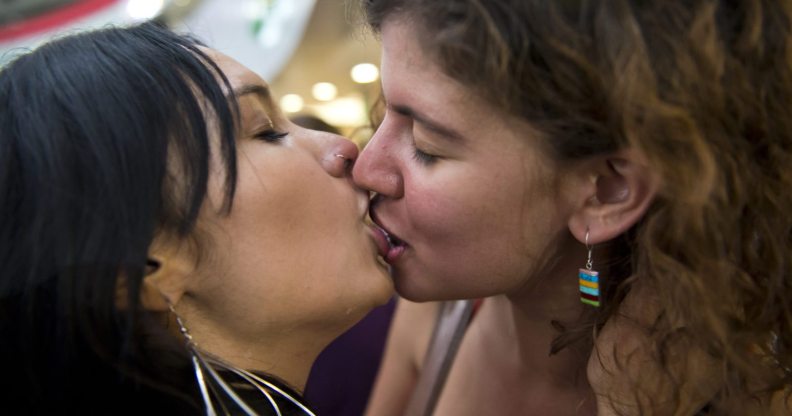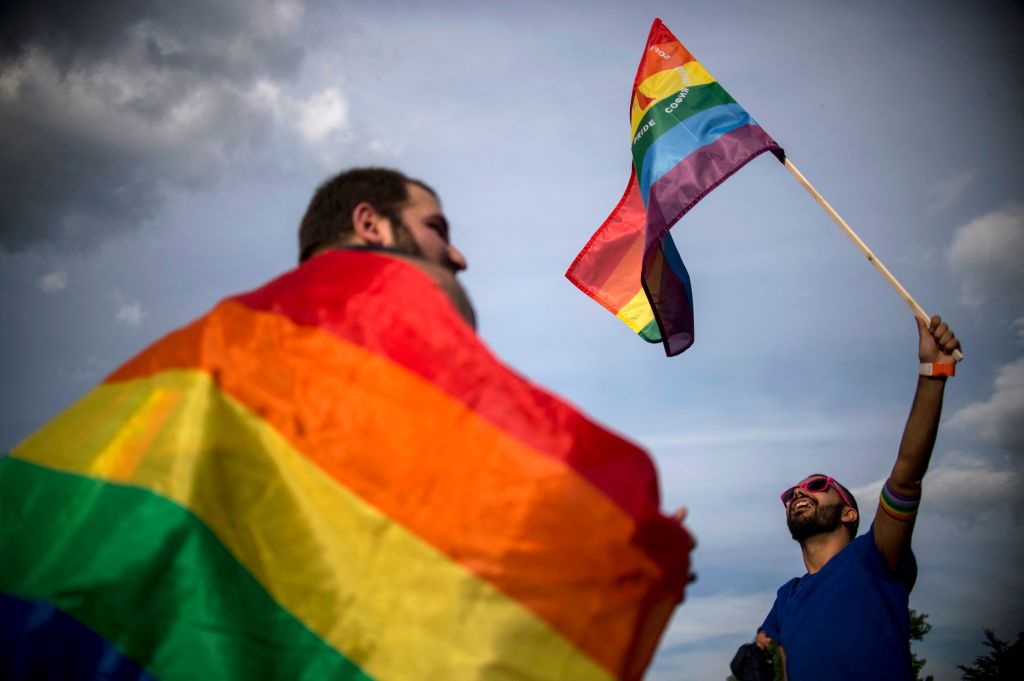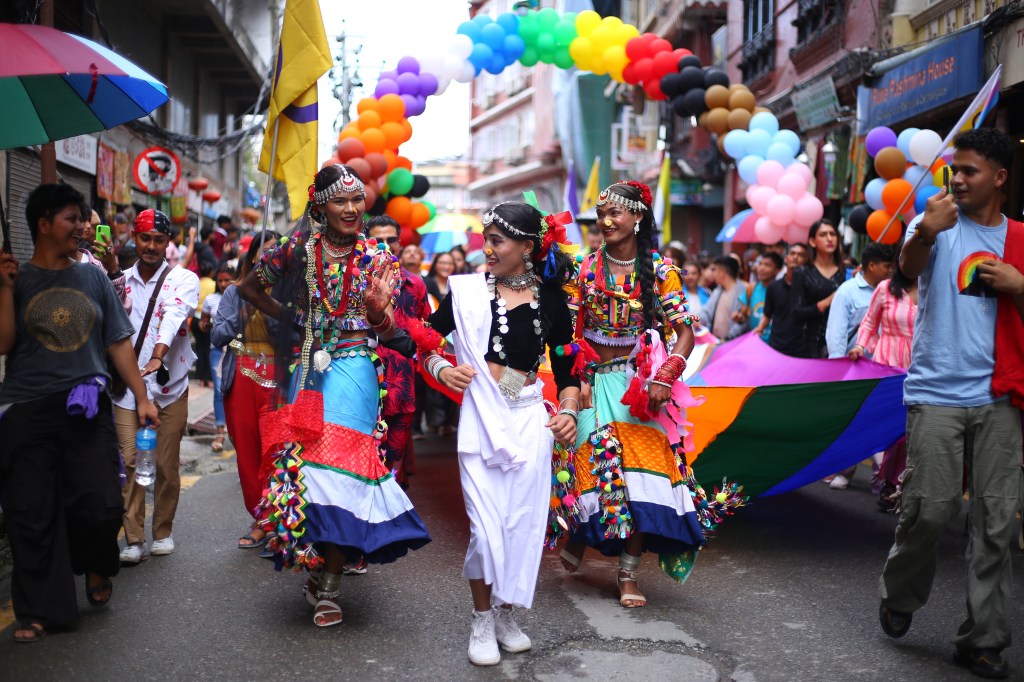What does the ‘plus’ stand for in LGBTQ+, and what is the history of the acronym?

Two women kiss each other during the International Day Against Homophobia (OMAR TORRES/AFP/Getty)
Two women kiss each other during the International Day Against Homophobia (OMAR TORRES/AFP/Getty)
If you’re wondering what the “plus” means in LGBTQ+, you’ve come to the right place.
LGBTQ stands for lesbian, gay, bisexual, transgender, queer/questioning and “plus” represents all other sexual identities including pansexual, asexual and omnisexual – amongst many others.
It’s the accepted and inclusive way to refer to the queer community, who can be grouped by one common theme: the fact they don’t identify as straight or cisgender, and the “plus” signifies that all other sexualities are also included, not just lesbian, gay, bisexual, transgender and queer/questioning.
It is, of course, good practice to become well-versed at understanding each of the subsects of sexuality and gender, so you can be prepared socially for people who identify as something other than lesbian, gay, bisexual or transgender.
What does the “plus” in LGBTQ+ stand for?
The “plus” is the least obvious part of the LGBTQ+ initialism, and stands for those who aren’t questioning their sexuality, but identify as part of a group that might not be so well known or understood.
We’ve outlined the definitions of some of the “plus” terms below.
GLAAD, or the Gay & Lesbian Alliance Against Defamation, has explained why we needed to add the plus at the end of LGBTQ.
“Coverage of LGBTQ issues has moved beyond simplistic political dichotomies and toward more fully realised representations, not only of the diversity of the LGBTQ community, but also of LGBTQ people’s lives, their families, and their fundamental inclusion in the fabric of… society,” the organisation states.
And this has made a tremendous difference, GLAAD adds.
“Today, LGBTQ people’s stories are more likely to be told in the same way as others — with fairness, integrity, and respect. Journalists realise that LGBTQ people have the right to fair, accurate, and inclusive reporting of their stories and their issues.
“Fair, accurate, and inclusive news media coverage has played an important role in expanding public awareness and understanding of LGBTQ people”.
A run through of some key LGBTQ+ identifiers covered by the “plus”:
Pansexual
Somebody who identifies as pansexual experiences feelings of attraction (physical, emotional or sexual) towards more than one gender identity. Similarly, omnisexual people can be attracted to all genders, although they can tend to date a higher percentage of one certain gender.
Sometimes, pansexual people will refer to themselves as “gender-blind”.
Asexual
A person who identifies as asexual typically experiences little or no sexual attraction to anyone else. The asexual scale can differ from those who have a low sex drive, to those who don’t desire sex whatsoever.
Pomosexual
If you are pomosexual, it means you refuse, avoid, or don’t fit into any particular sexual orientation label that we already have. The idea is that pomosexuality (or being pomoromantic) aims to challenge strict categorisations of who you love or are attracted to and aims to show that the world is full of many people that you may want to be with.
Abrosexual
Abrosexuality is when you have different levels of sexual or romantic attraction to various people and genders throughout your life.
The strictest dictionary definition for someone who is abrosexual is someone who has “a fluid sexual orientation”. For example, you could be gay one day, asexual the next, then polysexual the day after that.
Intersex
A person who is born with variations in sex characteristics including chromosomes, gonads, sex hormones, or genitals that don’t fit the typical ‘male’ or ‘female’ definitions. This can include genital ambiguity. Intersex people, like everyone, can identify as any gender.
Genderfluid
People who are aware of the flexibility of their own gender, and may change their gender throughout their life.
A brief history of the LGBTQ+ acronym

The term ‘LGBTQ+’ aims to be as inclusive of as many groups of people as possible. However, the ways we describe the kaleidoscopes of sexual and gender orientations are always changing and evolving.
The sexual revolution of the 1960s gave birth to a train of thought which insisted that those who identified as non-straight should have their own term. The upshot of that was the term gay, which was positively adopted by the community in the 1970s. It was paired with the term “lesbian” and the two gendered terms became the norm.
The term LGBT came to the fore in the late 1980s, as activist groups rallied for an inclusive description of all those who identified as non-straight. In the 1990s, the term was accepted by those inside and outside the community.
However, tension between various factions of the community has sprung up over the use of the term.
To some, LGBT no longer seems representative of one community, with people identifying as identities which couldn’t be defined within the LGBT mould.
This thought led us to our current incarnation of LGBTQ+, which importantly includes those questioning their identities, as well as a ‘plus’ for the raft of others who feel different in a variety of ways. However, a debate still rages over how we should define our community, and whether or not we are truly one “community” after all.
The academic Eleanor Formby has even said: “I’m not sure that community is a very suitable word for such a diverse group of people.”
Eleanor’s research, conducted at Sheffield Hallam University, studied 600 responses about the phrase “LGBT community”.
She insists that “the concept is important but when it is used in the singular, which it so often is, this is not helpful to many LGBT people, not least because not all feel, or wish to be, included within a singular uniform community”.
“The word community is rarely, if ever, used for people identified as part of majority groups, for example, white community, able-bodied community or heterosexual community, so why do we use it for so-called minority groups?”
What other variations of LGBTQ+ are there and what do they stand for?

The ever-evolving term LGBTQ+ has two common variants, although we can expect these to grow and evolve.
One is LGBTQIA, coined at the University of California, which introduced intersex and asexual to the fold.
There is also the even heftier LGBTTQQIAPP – lesbian, gay, bisexual, transgender, transsexual, queer, questioning, intersex, asexual, ally, pansexual – but there has been an inevitable backlash to that super long name.
For now though, it’s pretty safe to assume that LGBTQ+ is an inclusive and respectful term for all those who don’t identify as straight, although it’s important to respond to the requests of minority groups who may prefer to be called by another, more specific name.

